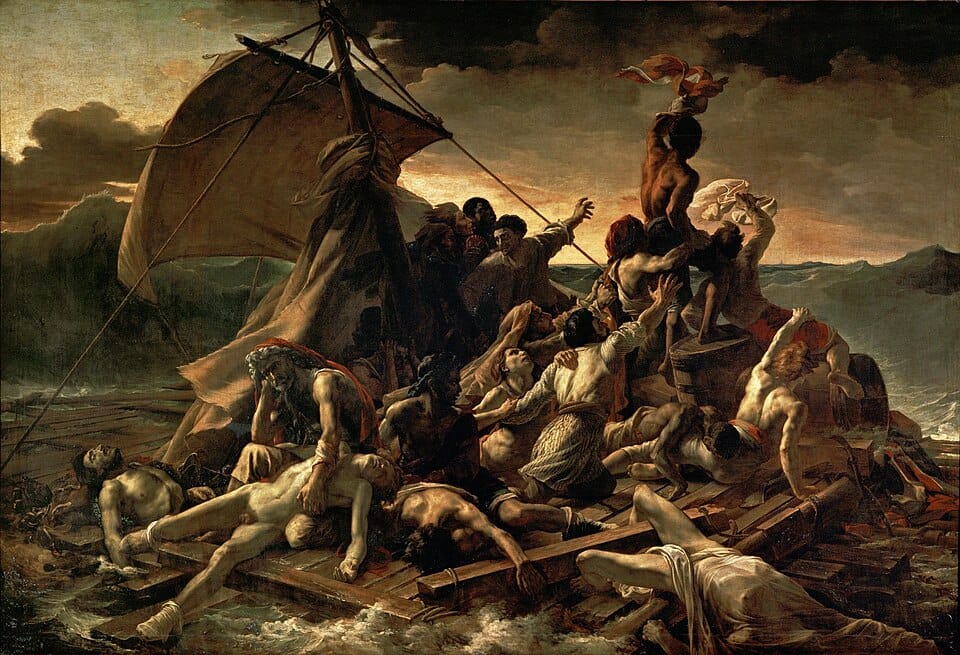Empathy, Order and the Collapse Myth: Why Civilisations Don’t Fall from Too Much Kindness
“Suicidal empathy” claims compassion threatens civilisation—but history shows the opposite. This essay exposes the myth, reveals the real causes of collapse, and explains why political leaders are promoting this idea as climate migration accelerates.

The phrase “suicidal empathy” has become fashionable in certain political and cultural circles. Popularised by evolutionary psychologist Gad Saad, the concept originally referred to a clinical or interpersonal tendency—when an individual’s excessive compassion leads them to tolerate abuse, self-harm, or chronically disadvantageous situations. In that narrow psychological sense, the idea has some validity. Therapists recognise analogous patterns: over-accommodating behaviour, compulsive caretaking, or empathic overreach that erodes personal boundaries.
But in recent years the term has migrated far beyond the therapist’s office. It has been taken up by influential commentators—including Elon Musk—and reframed as a civilisational diagnosis. In this expanded use, “suicidal empathy” is presented as a threat not to an individual’s wellbeing, but to the survival of entire societies. Compassion becomes a geopolitical weakness; mercy becomes a structural hazard; generosity becomes a vector of decline.
It is a dramatic story. It sounds profound.
It is also historically baseless.
Civilisations do not fall because they cared too much. They fall because the systems that enable compassion—institutions, cohesion, governance, shared purpose—begin to erode.
Below, we examine what collapse literature actually shows, and then pivot to the uncomfortable question: if the idea is false, who benefits from promoting it?
Looking Back: What Shows Up in the Collapse Literature
When historians, archaeologists and complexity scientists study why large polities fail, they repeatedly point to internal dysfunction, not excessive tenderness. Three themes dominate.
1. Corruption, Elite Self-Interest and Institutional Decay
A study of the late Roman Empire by Xinyao Zhang argues that over-centralisation and corruption among the elite created a “political dilemma” that contributed to Rome’s eventual collapse, with centralisation initially beneficial but ultimately corrosive once it became a vehicle for abuse and maladministration.
A working paper by Georgios Melios on Europe-wide political trust and corruption finds that perceived corruption is a significant determinant of trust in national governments, particularly in countries where austerity was present
In other words: self-interest eats harmony for breakfast.
Rome’s declining will to maintain borders, fund public goods, or discipline its own elites was not a sign of kindness—it was a sign of rot.
2. Complexity, Diminishing Returns and System Collapse
Joseph Tainter’s classic theory argues that societies collapse when the costs of complexity exceed the benefits. Bardi, Falsini & Perissi (2018) provide a biophysical model supporting this, showing how increasing bureaucratic and infrastructural burden can push societies into negative return on investment.
More complexity, same resources, less payoff.
What could possibly go wrong?
3. Loss of Cohesion, Trust and Adaptive Institutions
A far more suitable and academically grounded source on this topic is the article “Moral Collapse and State Failure: A View from the Past” by Blanton, Feinman & Kowalewski (2020). The authors argue that when leaders abandon established norms of good governance—failing to curb corruption, uphold fairness, or act as moral exemplars—the public’s trust in institutions erodes. As that trust collapses, the “moral community” that binds society together fractures, weakening cooperation and making the state increasingly brittle and vulnerable to failure.
Collapse isn’t about being too nice; it’s about being too brittle, with institutions hollowed out and unable to maintain social cohesion.
Why the “Too Much Empathy” Narrative Fizzles Historically
Let’s examine three commonly cited case studies.
The Western Roman Empire
Yes, Rome fell. But:
- civic apathy
- economic mismanagement
- moral corruption among elites
- demographic decline
- administrative fragmentation
These dominate the literature.
A study by Jonathan J. Price (2020) titled “Structural Weaknesses in Rome’s Power?” traces how Roman historians themselves anticipated that the empire’s decline would stem from internal sources—weak institutions, factionalism and moral decay—rather than purely from barbarian invasions. Collapse was less about being too generous and more about being built on unstable foundations.
Another study (Zhang, 2022) argues that the late Roman Empire’s internal deterioration stemmed from the political dilemma of over-centralisation and widespread corruption, which weakened state capacity and institutional resilience — not from excessive empathy.
If excess compassion played a role, it is hiding behind centuries of court intrigue, bribery, lead poisoning, and unpaid soldiers.
The Byzantine / Eastern Roman Empire
Decline in the Eastern Roman (Byzantine) Empire was slow and punctuated by a familiar mix of internal problems:
- bureaucratic inertia
- elite indulgence and luxury
- over-reliance on mercenaries
- internal religious and political schisms
A detailed case study by Kostis Smyrlis in the chapter “Sybaris on the Bosphoros: Luxury, Corruption and the Byzantine State under the Angeloi (1185–1203)” argues that, under the Angeloi dynasty, court luxury, corruption, abusive taxation and the concentration of wealth in the capital steadily weakened the empire’s finances, administrative capacity and provincial loyalty. The state looked impressive on the surface, but its ability to fund and organise effective defence was being hollowed out from within.
Inviting “outsiders” in with open arms makes a tidy modern morality tale.
But the real story is more prosaic: corruption and mismanagement held the door open long before any guest arrived.
The Abbasid Caliphate
The Abbasid Empire — once a centre of scientific and cultural flourishing — declined under the pressure of administrative mismanagement, elite luxury, and systemic corruption. Historical analyses consistently emphasise how weakening central authority and factional power struggles eroded cohesion long before the Mongol invasions delivered the final blow.
Modern research on corruption and trust (e.g., Melios, 2020) helps illustrate the broader principle: corruption reliably undermines institutional stability, public confidence, and the capacity for coordinated action — the very dynamics that appear throughout Abbasid decline.
It was less “love thy neighbour”
and more
“why bother keeping the house in order if everyone’s quietly stealing the furniture?”
So If Not “Too Much Empathy”, What Are We Really Talking About?
The dynamics are better framed as:
- empathy unmoored from purpose
- mercy untethered from order
- compassion without institutional resilience
In short:
- Compassion without consequence → indulgence
- Tolerance without discernment → dissolution
- Inclusion without integration → fragmentation
Empathy isn’t the problem.
Entropy is.
The Politics of “Suicidal Empathy”: Why This Rhetoric Exists, and What It Prepares Us For
Here is the pivot.
If “suicidal empathy” is not supported by history, why is it suddenly everywhere?
Because it is politically useful—not for understanding the past, but for preparing for the future.
Specifically: the coming wave of climate-driven migration.
The Coming Century of Human Movement
Climate science no longer whispers. It shouts.
- Xu et al. (2020) estimate up to 3.5 billion people may live outside the “human climate niche” by 2070.
- Lenton et al. (2023) estimate 1.7–3 billion exposed to niche loss by late century.
- A major review by Elliott et al. (2013) finds that climate-driven reductions in water availability, rising temperature stress and shifting rainfall patterns will severely constrain agricultural production globally, thereby threatening food systems across multiple continents.
- Waters (2025) in Journal of Refugee Studies argues that climate-driven migration will become one of the foremost geopolitical challenges of this century. According to his review, rising temperatures, ecosystem collapse and disrupted livelihoods mean that movement of human populations may not be a side effect of climate change—it may be the central strategic question.
This is not “migration” as we know it.
It is planetary triage.
Millions—perhaps tens or hundreds of millions—will seek survival elsewhere.
The Quiet Realisation Among Global North Leadership
Though rarely voiced publicly, many governments and corporations know:
- Their nations are perceived as safer.
- Huge populations will attempt to move north and west.
- No political system can accept climate-scale inflows without backlash.
- Sympathy for the desperate could override restrictive policies.
Thus a strategic dilemma emerges:
How do you prepare your population to refuse sanctuary to people whose suffering your country helped cause?
Answer:
Emotionally inoculate them now.
Why “Suicidal Empathy” Is So Useful to Elites
1. It reframes compassion as national self-harm
Refuse refugees or migrants? Not cruel—just prudent.
2. It gives moral cover to hardening borders
If empathy is dangerous, steel gates become “responsible”.
3. It provides pseudoscientific legitimacy
“Evolution didn’t design us to care for outsiders.”
(Convenient, if scientifically thin.)
4. It dehumanises future climate refugees
If compassion is treasonous, pity becomes weakness.
5. It hides the real culprit: climate inaction
Blame citizens’ emotions, not emissions.
Hardening Hearts Before Hardening Borders
This is the political purpose.
Before governments can refuse climate-displaced millions, they must first neutralise empathy—the emotional circuit that urges action, generosity, shared humanity.
Thus the narrative:
“Empathy is dangerous.”
“Compassion will destroy us.”
“Helping others is suicide.”
It is not analysis.
It is conditioning.
What We Should Be Doing (Instead of Hardening Hearts and Borders)
In place of preparing our citizens to refuse empathy, we should be mobilising them for collective rescue. The Ehrlichs’ study indicates that the greatest threat to modern civilisation is not migration, but our failure to re-engineer our social, economic and environmental systems. They argue that the path to resilience is not through fortification of hearts and borders, but through:
- Reducing over-consumption and resource strain: As the paper emphasises, high levels of consumption by the rich and growing population size aggravate systemic stress.
- Strengthening institutional capacity and global cooperation: The study calls for unprecedented collaboration between civil society, governments and scientific communities to design and implement transformative solutions.
- Rediscovering sustainable civilisation logic: Instead of seeing refugees as threats, we should view climate-displaced persons as early signals of systemic breakdown—and thus as part of the impetus to change.
- Prioritising adaptation and mitigation over militarised defence: While borders may hold in the short term, ultimately the only sustainable defence against mass displacement is a world where fewer people are forced from home in the first place.
In short, the solution is not emotional drain-resistance—it’s empathy mobilised as agency, not abdicated as a weakness.
Conclusion
Civilisations do not collapse because they were too kind. They collapse because they lost the institutions, values and systems that enabled them to care. And the new risk is not an excess of compassion—it is a deficit of purposeful compassion.
We are now at a choice point:
Will we harden hearts and tighten borders in preparation for displaced masses?
Or will we mobilise hearts and rewire systems, firming up both empathy and order, enabling inclusive rescue rather than fearful exclusion?
The real weapon is not the wall we build. It’s the vision we fail to summon.
We should see every climate-migrant not merely as a burden—but as a call to action. Our future depends not on refusing humanity, but on fulfilling it.
Civilisations do not fall from too much kindness.
They fall from corruption, fragility, indifference—and the moral cowardice of leaders who fear compassion more than catastrophe.
The real danger is not empathy.
The real danger is weaponised indifference.
References
- Zhang, X. Centralization and Corruption: The Political Dilemma of the Late Roman Empire. In: Proceedings of the 2022 8th International Conference on Humanities and Social Science Research (ICHSSR 2022), Advances in Social Science, Education and Humanities Research, pp. 1481–1485. DOI: 10.2991/assehr.k.220504.268
- Melios, Georgios. Europe in Crisis: Political Trust, Corruption and Austerity. SSRN Electronic Journal, 2020. DOI: 10.2139/ssrn.3847633
- Bardi, U., Falsini, S., & Perissi, I. (2018). Toward a General Theory of Societal Collapse. A Biophysical Examination of Tainter s Model of the Diminishing Returns of Complexity. DOI: 10.48550/arXiv.1810.07056
- Whitehouse D. Joseph A. Tainter. The collapse of complex societies. xiii + 250 pages, 30 figures, 7 tables. 1988. Cambridge: Cambridge University Press; ISBN 0-521-34092-6 hardback £27.50 & $39.50. Antiquity. 1988;62(237):798-800. DOI: 10.1017/S0003598X00075256
- Blanton, R. E., Feinman, G. M., & Kowalewski, S. A. (2020). Moral Collapse and State Failure: A View from the Past. Frontiers in Political Science, 2: 568704. DOI: 10.3389/fpos.2020.568704
- Price, Jonathan J. (2020). Structural Weaknesses in Rome’s Power? In K. Berthelot (Ed.), Reconsidering Roman Power (pp. 217-238). Rome: Publications de l’École Française de Rome. DOI: 10.4000/books.efr.4983
- Smyrlis, Kostis. “Sybaris on the Bosphorοs: Luxury, Corruption and the Byzantine State under the Angeloi (1185-1203).” Sybaris on the Bosphorοs: Luxury, Corruption and the Byzantine State under the Angeloi (1185-1203), in Byzantium, 1180-1204: “The Sad Quarter Of A Century”?, Ed. A. Simpson (Athens: National Hellenic Research Foundation, 2015), 159-178. [Link]
- C. Xu, T.A. Kohler, T.M. Lenton, J. Svenning, & M. Scheffer (2020). Future of the human climate niche, Proc. Natl. Acad. Sci. U.S.A. 117 (21) 11350-11355. DOI: 10.1073/pnas.1910114117
- Lenton, T.M., Xu, C., Abrams, J.F. et al. Quantifying the human cost of global warming. Nat Sustain 6, 1237–1247 (2023). DOI: 10.1038/s41893-023-01132-6
- J. Elliott, D. Deryng, C. Müller, K. Frieler, M. Konzmann, D. Gerten, M. Glotter, M. Flörke, Y. Wada, N. Best, S. Eisner, B.M. Fekete, C. Folberth, I. Foster, S.N. Gosling, I. Haddeland, N. Khabarov, F. Ludwig, Y. Masaki, S. Olin, C. Rosenzweig, A.C. Ruane, Y. Satoh, E. Schmid, T. Stacke, Q. Tang, & D. Wisser, Constraints and potentials of future irrigation water availability on agricultural production under climate change, Proc. Natl. Acad. Sci. U.S.A. 111 (9) 3239-3244 (2014). DOI: 10.1073/pnas.1222474110
- Waters, M. C. (2024). Preparing for climate migration and integration: a policy and research agenda. Journal of Ethnic and Migration Studies, 51(1), 4–23. DOI: 10.1080/1369183X.2024.2438449
- Ehrlich, P. and Ehrlich, A. (2013). Can a Collapse of Global Civilisation Be Avoided? Proc. R. Soc. B 280: 20122845. DOI: 10.1098/rspb.2012.2845




